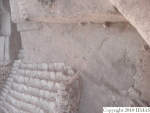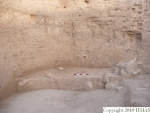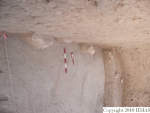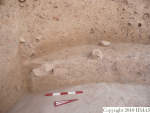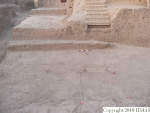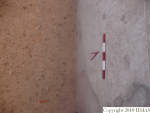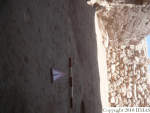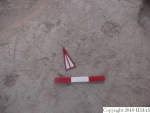1. OVERVIEW
| Roster | Date | Author | Record |
|---|---|---|---|
| Category | !! | !! | surface |
| Best definition | 2009-07-25 | cJC | floor, type b [Input: T822CJC2.j] |
| Summary | 2009-09-01 | cJC | Very hard gray surface in k15. This surface was probably created by the erosion (f366) seen in the south section. Water from the erosion made it very hard. Originally thought to be a either a glacis (f319) or a sloping surface across the whole area (k110, k5 and k15) it turned out to be an erosion surface confined primarily to k15. [Input: T901CJC.j] |
| Best image | 2009-09-01 | cJC | 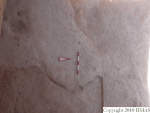 v174 [Input: T901CJC.j] |
2. IDENTIFICATION
Designation
| Roster | Date | Author | Record |
|---|---|---|---|
| Description (summary) | 2009-07-25 | cJC | Very compacted surface with some small pebbles inside. It was exposed when removing f338. It is very hard and a light gray color. [Input: T725CJC.j] |
| 2009-08-02 | cJC | This surface slopes down from east to west. In k5 it is 8930(m6151+158-143) in the SE corner sloping down to 8855 (m6152-124+143) in the SW corner. [Input: T802CJC.j] | |
| 2009-08-10 | cJC | The surface of f339 is a very flat gray surface. It is very hard and appears smooth. When the materials above it were picked they separated easily from the surface of f339. Because it overlays more than one feature it comes apart slightly differently. In the northern part when picked it comes off attached to large brown chunks (about 15cm in size). Under these chunks we found the reddish layer f348. In contrast in the SW portion of f339 when picked it comes off in an extremely thin layer and immediately overlays a pink layer (f373). The portion underlying f339 in the north with the chunks has occasional charcoal inclusions and small white laminations from roots or water. [Input: T810CJC.j] |
3. STRATIGRAPHY
Recovery/Assignment
| Roster | Date | Author | Record |
|---|---|---|---|
| Argument | 2009-08-10 | cJC | I think that this layer is probably a result of the erosion we see in the south section of k110, k5 and that continues in k15. I suggest this because f339 overlays more than one feature (including f365, f373 and f348) which indicates that the layers underneath were eroded before they were overlaid by the gray layer of f339. I think the reason that it comes apart in different ways when picked is because after the erosion the water and dust settled and bonded with the different exposed layers in different ways. For example in the southwest corner it only rested on top of the pink (f373) while in the northern part it became more bonded with the layer underneath (f348). Also, the brickfall rests directly on top of this layer which suggests it was the last moment in time, sealing off the eroded layers before the brickfall fell on top of it. [Input: T810CJC.j] |
| Harmonization | 2009-09-02 | cJC | When we first began excavating we thought that perhaps f339 extended across all of J2, but when we excavated it, f339 was contained to only k15. [Input: T830CJC.j] |
| Evolution | 2009-08-02 | cJC | We attributed this feature to the accumulation immediately under the brickfall when we scraped back the south section of k5 and k15. It was a hard gray layer sloping down from east to west. It appeared to be the same as f344 in k110. When we began removing the feature it became unclear if this was the same feature as it appears in the SW corner of k5 that the brickfall directly overlays an uneven surface with embedded pebbles. When we remove the pebble-surface (f362) we hope to see if f362 is a wash that cut the surface of f339 or if f339 did not continue under the brickfall as assumed. We will use the south section to verify the slope (or non-existence) of this feature. [Input: T802CJC.j] |
| Notes on recovery | 2009-07-25 | cJC | We have not excavated this feature yet. [Input: T725CJC.j] |
Volumetric Localization
| Roster | Date | Author | Record |
|---|---|---|---|
| Locus | 2009-07-25 | cJC | k4 [Input: T822CJC2.j] |
| 2009-09-02 | cJC | k15 [Input: T830CJC.j] | |
| Relays (applicable to elements) | 2009-08-10 | cJC | r1102 (39154 49915 - 8705 / Relay location: SW corner of remaining portion) [Input: T820CJCR.j] |
| 2009-08-10 | cJC | r1103 (39211 50023 - 8721 / Relay location: Center point of NW edge) [Input: T820CJCR.j] | |
| 2009-08-10 | cJC | r1104 (39232 50175 - 8733 / Relay location: NE corner point) [Input: T820CJCR.j] | |
| 2009-08-10 | cJC | r1105 (39233 50100 - 8724 / Relay location: NW corner point) [Input: T820CJCR.j] | |
| 2009-08-10 | cJC | r1106 (39041 50098 - 8714 / Relay location: SE corner) [Input: T820CJCR.j] | |
| 2009-08-10 | cJC | r1107 (39148 50173 - 8724 / Relay location: point on eastern edge) [Input: T820CJCR.j] | |
| M#/elev @top | 2009-07-25 | cJC | 8724 [Input: T822CJC2.j] |
| M#/elev @bottom | 2009-07-25 | cJC | 8712 [Input: T822CJC2.j] |
Contact Association
| Roster | Date | Author | Record |
|---|---|---|---|
| Type of contact: latest events | 2009-08-29 | cJC | f338 (brickfall) covers f339 (floor, type b) [Input: T829CJC.j] |
| 2009-08-29 | cJC | f341 (brickfall) overlays f339 (floor, type b) [Input: T829CJC.j] | |
| 2009-08-01 | cJC | f354 (lens) overlays f339 (floor, type b) [Input: T801CJC.j] | |
| 2009-08-29 | cJC | f371 (accumulation D) overlays f339 (floor, type b) [Input: T829CJC.j] | |
| Type of contact: contemporary events/movable items | 2009-08-10 | !! | q882.1 (carbon sample) sits in f339 (floor, type b) [Input: T826CJC2.j] |
| 2009-08-10 | !! | q882.2 (clay lump) sits in f339 (floor, type b) [Input: T826CJC2.j] | |
| 2009-08-10 | cJC | q882 (pottery) sits in f339 (floor, type b) [Input: T826CJC2.j] | |
| Type of contact: earliest events | 2009-08-10 | cJC | f339 (floor, type b) covers f373 (lens) [Input: T810CJC.j] |
| 2009-08-10 | cJC | f339 (floor, type b) overlays f348 (floor, type a) [Input: T810CJC.j] | |
| 2009-08-10 | cJC | f339 (floor, type b) overlays f365 (floor, type d) [Input: T810CJC.j] | |
| 2009-08-30 | cJC | f339 (floor, type b) overlays f374 (floor, type c) [Input: T830CJC.j] |
Time Sequencing
| Roster | Date | Author | Record |
|---|---|---|---|
| Stratum (to which element belongs) | 2011-11-11 | cJC | s161J2B [Input: VY11CJC.j] |
| Phase (to which element belongs) | 2010-11-28 | !! | ^ersn2 [Input: T914CJC.j] |
| 2011-11-11 | !! | h7jJ2B [Input: VY11CJC.j] | |
| Stratigraphic reasons of assignment | 2009-09-16 | cJC | Assigned to the same stratum as the erosion (f366) that presumably created this feature. [Input: T916CJC.j] |
| Other reasons, reservations, qualifications | 2011-05-16 | cJC | Possibly formed by the erosion of f366 [Input: V516CJC.j] |
| 2011-11-21 | cJC | The nature of this feature is unclear, but it appears to be a surface formed by the processes of erosion. It may have been partially eroded in the third millennium but it was furhter damaged in the mid-Mittani when the erosion of f366 happened. For this reason I have assigned this feature to the Mittani although it could be revised with further information. Similar to f371. [Input: VY21CJC.j] |
4. TYPOLOGY
Morphology
| Roster | Date | Author | Record |
|---|---|---|---|
| Ware or Material, species | 2009-07-25 | cJC | cl [Input: T822CJC2.j] |
| Color | 2009-07-25 | cJC | gray [Input: T822CJC2.j] |
| Hardness, compaction | 2009-07-25 | cJC | very hard [Input: T822CJC2.j] |
| Texture, surface finish | 2009-07-25 | cJC | platy [Input: T822CJC2.j] |
| 2009-08-29 | cJC | smooth surface [Input: T829CJC.j] |
6. REFERENCE
Analogical Record
| Roster | Date | Author | Record |
|---|---|---|---|
| View/drawing of features | |||
Disposition
| Roster | Date | Author | Record |
|---|---|---|---|
| Removed (feature), discarded/missing (item) | 2009-07-25 | cJC | T811 [Input: T822CJC2.j] |
